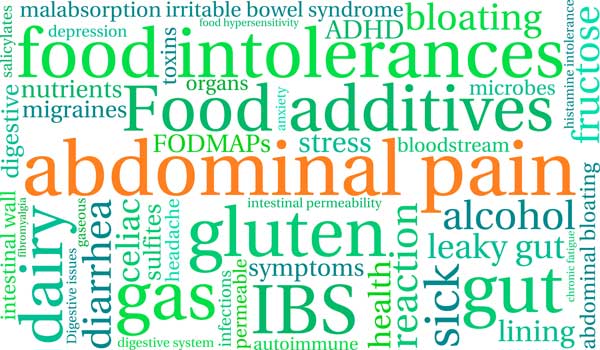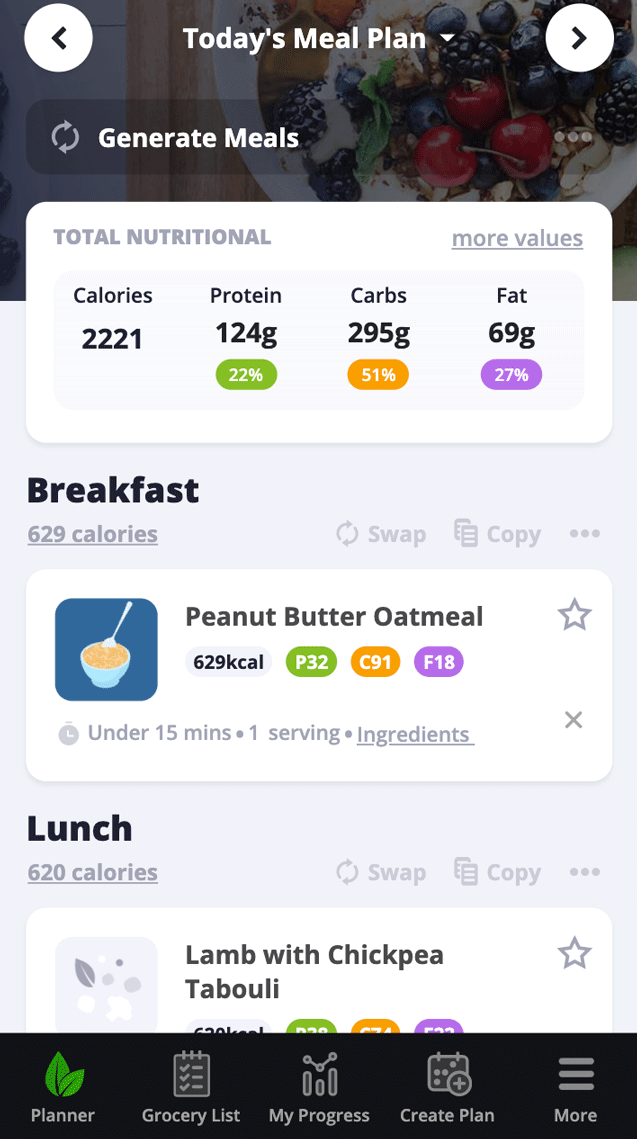All You Need to Know About the FODMAP Diet

If you're suffering from often occurring digestive distress like pain, bloating and constipation, or if you know that you have ongoing problems with IBS, there are quite a few things that can contribute to the worsening or appearance of your symptoms. One of these things is speculated to be FODMAPs.
FODMAPs are a small group of compounds found in foods we consume on a daily basis. They have been linked with increasing the symptoms of many gastrointestinal problems. Many scientific pieces of research and case studies have shown a close connection between the two and more and more people keep giving this diet a try.
If you're interested in learning more about this interesting dietary approach towards digestive issues and you wish to give it a try for yourself, here are a few things you should know about FODMAPs if you yourself experience any discomfort.
If you are more interested in trying out our Meal Planner to make a Low FODMAP diet plan then please click here instead.
Topics covered in this guide
What Exactly are FODMAPs?
What is the FODMAP diet?
Common FODMAPs in our everyday diet.
Should gluten be avoided?
Can probiotics offer a solution?
How long should the FODMAP diet last?
How to get started on a low FODMAP diet.
Which foods to pick and which to avoid?
Frequently Asked Questions about FODMAPs and the diet.
What exactly are FOPMAPs?
This word is an acronym and it actually stands for “-Fermentable Oligo-, Di- and Mono-saccharides and Polyols” and is there to describe a group of some short-chain carbohydrates and sugar alcohols that are present in some particular foods.
In simpler words FODMAPs are:
Fermentable
When something is fermentable, it means that it can be broken down by coexisting bacteria in our digestive track.
Oligosaccharides
Originating from the Greek language, “oligo” means few and is here to show us the presence of a small number of monosaccharide molecules put together in a chain. “Saccharide” simply means sugar.
Disaccharides
Here, “di” shows us that the sugar contains two monosaccharide molecules.
Monosaccharides
With “mono” meaning single, these are single sugar molecules (like glucose) that cannot be hydrolyzed in order to give a simpler sugar.
Polyols
They are sugar alcohols like many commonly used sweeteners and thankfully, they are definitely not going to make you drunk!
Instead of having to write all these long words down when referring to these compounds, it was decided that it is a lot simpler to just call them FODMAPs instead.
Now that you know the very basics, it's time to introduce to you the meaning of a FODMAP diet.
What is the FODMAP DIET?
The FODMAP diet was first researched and developed by Monash University in Australia and led by Professor Peter Gibson. It is a diet plan where foods that contain these compounds that we mentioned earlier are eliminated for a short period of time from a person's diet in order to achieve some wanted results.
If those sneaky compounds are not absorbed in the small intestine, they will then pass on to the large intestine where bacteria that live there will be able to break them down instead.
This will result in the manifestation of various symptoms such as:
- Strong abdominal pain
- Bloating
- Flatus, aka gas
- Altered Bowel Habits
These symptoms occur because these dietary compounds are not properly absorbed or perhaps not even absorbed at all and they go on to exert an osmotic effect that drags water into the intestine. Along with that, the fact that these molecules can be fermented from colonic bacteria results in the generation of gases such as carbon dioxide and methane.
The appearance of those elements on the inside of our intestines causes their walls to stretch and stimulate nerves in our gut. As a result, we are left with feelings of intense pain and discomfort, similar to those that patients with IBS experience.
The FODMAP diet eliminates completely or reduces all sources of these compounds from a person's diet for a short amount of time. After this elimination phase, you can start adding foods high in FODMAPs back in your diet, in order to help you identify which food triggers your symptoms.
Common FODMAPs in our everyday diet
Before we get into talking about particular foods, let's keep in mind which compounds we need to avoid:
- Excess fructose
- Lactose
- Polyols
- Fructans (also known as inulin)
- Galactans
The best thing to do if you wish to follow this diet is to start reading labels carefully. Try to avoid high FODMAP foods that could possibly cause unwanted symptoms. Specific foods to avoid as well as ingredients can be found later on in the article.
Summary: FODMAPs are short-chain carbohydrates and sugar alcohols that are present in some foods and if they are not properly absorbed in our intestines, they tend to be broken down by colonic bacteria. A FODMAP diet aims to eliminate these compounds from a person's diet for a short period of time in order to help reduce painful and uncomfortable symptoms.
Should gluten be avoided?
Many people might come to think that gluten is also a part of the FODMAPs, as it is an element that causes a lot of gastrointestinal sensitivities to people. When it comes to FODMAPs though, gluten is simply not a part of this team. This happens because gluten is a protein, whereas FODMAP compounds are all carbohydrates.
Even though gluten is not part of this category, studies have shown that it is best if people with FODMAP sensitivities avoid or reduce their consumption of products that contain gluten. This mainly happens because if you happen to have both a gluten and FODMAP sensitivity, you might not get the right results during your elimination phase.
In most cases though, gluten-free products are recommended in a FODMAP diet as they do not contain high amounts of fructans and oligosaccharides.
Can probiotics offer a solution?
Probiotics are live microorganisms that are consumed by us through our diet and in adequate amounts can offer great benefits to our bodies. The most common probiotic organisms are Bifidobacteria, Lactobacilli or Saccharomyces boulardii.
Patients who suffer from IBS or other similar gastrointestinal issues are known to have abnormal commensal microbiota which pretty much means that they do not have enough of these friendly bacteria in their system.
Probiotics are believed to be able to help ease the symptoms as they can help restore fully or at least partly, the functionality or the microbiota. There are many systematic reviews and meta-analyses focusing on the usage of probiotics in IBS, most if not all of which are supporting the benefits of probiotics in gastrointestinal issues and some of the trials even show a symptom relief at a minimum of 50%.
When it comes to a FODMAP diet, the problems come from the fact that these compounds possibly disturb the bacterial balance in our gut. The gut microbiota is known to be responsive and adaptable to a person's diet. Many studies have shown that people suffering from IBS have experienced a reduction of the microbiota due to the poor absorption of the FODMAPs.
As a result, it is thought that probiotics will truly be beneficial in a FODMAP diet. The thing here is that it is important to know which probiotic should be given for the symptom profile of each patient as well as the source of the probiotic.
Some of the best sources of probiotics that are compatible with a low FODMAP diet are:
- Lactose free yogurt
- Tempeh
- Red Cabbage Sauerkraut
- Lactose free Kefir
- Miso
Last but not least, when it comes to IBS, some studies have also shown that some patients have either experienced no benefits or even a worsening of symptoms when consuming probiotics. Scientists have noticed that this is mainly occurring with probiotic supplements though.
Since that is a risk that is present, it would be best if you don't experiment with adding any new probiotic supplements in any phase of the diet.
On the other hand, if you've already been using a particular supplement and have had positive results, you can surely continue using it during your low FODMAP diet.
Summary: Probiotics can possibly offer some relief from FODMAPs in our diet. It is important to know which source we should get them from and avoid taking new supplements while being on the diet.
How long should the FODMAP diet last?
The whole point of this diet plan is to eventually find out which one of these compounds affects your intestines and causes these unwanted symptoms. That being said, the FODMAP diet is not a permanent solution. While it will help you find relief from the discomfort pretty quickly, you should not follow it for more than 3-8 weeks.
This is kind of a strict rule as this diet is very restrictive and makes you eliminate many food groups from your diet, as we saw earlier. After you finish the elimination part of the diet, you will need to start reintroducing foods containing one FODMAP at a time, until you manage to figure out which ones are responsible for your symptoms.
While eliminating compounds such as Lactose and Polyols will truly help your gut get back on track, heal and start working a lot better, the elimination period should only last according to expert's advice so that no other issues come up due to the constant restriction of foods.
How does it work?
As it was mentioned earlier, the first part of the diet is called the elimination phase and it lasts anywhere from 3 to 8 weeks. In this first stage, all foods containing FODMAPs should be excluded from your diet or at least strictly limited.
After this first phase, you can slowly start incorporating foods back into your diet that contain a higher amount of FODMAPs. This phase is called the reintroduction plan or the rechallenge phase. The trick here is to make sure that you start by adding one specific FODMAP at a time and observe how your body reacts to it.
Once you have managed to identify all of the FODMAPs that are the cause of your symptoms, you will be able to know what you can and cannot eat. This will help you get rid of the painful symptoms and help you feel a lot better in the long run.
Summary: A low FODMAP diet should not last more than 3-8 weeks as it is very restrictive. It consists of 2 phases, one where you eliminate all high FODMAP foods and one where you start reintroducing them one by one while observing the effects they have on your body.
Which foods to pick and which to avoid?
While all foods that contain FODMAPs are important in the generation of symptoms, different subgroups are known to contain them in different servings. Here are some foods you should avoid during your elimination phase, as well as foods to consume and substitute the high FODMAP sources with.
Foods to avoid:
1) Fructose:
Fruits: apples, pears, nashi pears, clingstone peaches, mango, sugar snap peas, watermelon, tinned fruit in natural juice.
Honey and Sweeteners like fructose and high fructose corn syrup.
Foods high in fructose: concentrated fruit sources; large serves of fruit, dried fruit, fruit juice.
2) Lactose:
Milk: cow, goat and sheep (regular & low-fat), Ice cream.
Yogurt: regular and low fat.
Cheeses: soft and fresh ones like ricotta and cottage cheese.
3) Polyols:
Vegetables: artichokes, asparagus, beetroot, Brussels sprout, broccoli, cabbage, cauliflower, fennel, garlic, leeks, okra, onions, peas, shallots, mushrooms.
Cereals: wheat & rye when eaten in large amounts, for example bread, pasta, biscuits, couscous.
Legumes: chickpeas, lentils, red kidney beans, baked beans.
Fruits: watermelon, custard apple, white peaches, rambutan, persimmon, plums.
4) Fructans and/or Galactans:
Fruits: apricots, cherries, longon, lychee, nectarine, pears, peaches, plums, prunes.
Vegetables: avocado, cauliflower, mushrooms, snow peas.
Sweeteners: sorbitol (420), mannitol (421), xylitol (967), maltitol (965), isomalt (953) and others ending in '-ol'.
Foods to pick:
1) Fructose:
Fruit: banana, carambola, grape, honeydew melon, passion fruit, paw-paw, raspberry, rockmelon, strawberry, tangelo.
Honey substitutes: maple syrup, golden syrup.
Sweeteners: any sweeteners except Polyols.
2) Lactose:
Milk: lactose-free rice milk.
Cheese: 'hard' cheeses including brie, camembert.
Yogurt: lactose-free.
Ice cream substitutes: gelati, sorbet.
Butter
3) Polyols:
Vegetables: bamboo shoots, bok choy, carrot, celery, capsicum, choko, choy sum, corn, eggplant, green beans, lettuce, chives, parsnip, pumpkin, silverbeet, spring onion (green only), tomato, bean sprouts, cucumber, squash, sweet potato
Onion/garlic substitutes: garlic-infused oil.
Cereals: gluten-free and spelt bread or cereal products.
4) Fructans and/or Galactans:
Fruits: blueberry, carambola, durian, grapefruit, kiwifruit, lemon, lime, mandarin, orange, raspberry, rockmelon.
Sweeteners: sugar (sucrose), glucose, and other artificial sweeteners not ending in 'ol'.
5) Essential to also add in your diet
Meats, Poultry fish and eggs: beef, chicken, canned tuna, eggs and egg whites, fish, lamb, pork, shellfish, turkey and cold cuts.
6) Optional
Beverages: small amounts of low FODMAP fruit and veggie juices (1/2 cup at a time), coffee and tea
Seasonings: most spices and herbs like olive oil, salt, pepper, soy sauce and vinegar.
From this list, there are some ingredients that can truly contribute to the worsening of your symptoms. Two that you should always look out for when following a low FODMAP diet are raw garlic and onion.
You can find an even more extended list here.
How to get started on a low FODMAP diet
After seeing all of the things you should avoid during this diet, it is more than normal to feel overwhelmed. You will probably feel very confused as to what you will be eating while you're not at home as well as what you can cook on an everyday basis. Here are some food choice tips and ideas to help you out while you're still getting started.
Things you can eat while you are out:
Gluten free breads are available in many restaurants nowadays so make sure to ask for them.
- Try drinking your tea or coffee without milk, with lactose free milk or with almond milk.
- You can still enjoy popcorn at the cinema.
- Any salad that contains low FODMAP veggies like kale, cucumber, tomatoes, green pepper etc. Be wary of the dressings though as many contain honey or other high FODMAP foods! You can always ask for some olive oil and some squeezed lemon juice.
- Smoothies made with low FODMAP veggies like bananas, blueberries, kiwis as well as your favorite plant milk or lactose free milk and a low FODMAP sweetener.
- Sushi as well as sashimi paired with soy sauce and wasabi.
If you're looking for some good low FODMAP recipes that will help you not miss out on any tasty foods you can search for recipes on My Diet Meal Plan using our Meal Planner . The option to search for Low FODMAP foods can be found in the Dietary Needs section.
There are many recipes that can truly show you that you can follow a low FODMAP diet without a big issue for the period of time that is needed. You can always mix and match ingredients and see which foods work the best for you and your preferences.
Summary: The FODMAP diet is quite restrictive, but it can also offer a number of foods that are easy to eat and make meals out of. As long as you're dedicated, you will be able to make the necessary changes.
Who can benefit from the low FODMAP diet?
Anyone who suffers from gastrointestinal problems and IBS could truly benefit from a diet like this. By following its stages correctly for a period of time, this diet will help you know if you have any intolerance to FODMAPs and it can truly help you improve your quality of life.
Is it easy to follow if you're a Vegan or Vegetarian?
In general, a FODMAP diet can be easy to follow for Vegans and Vegetarians as it includes a nice variety of plant based ingredients as well as some cheeses and lactose-free foods that are parts of any balanced diet.
If you keep in mind though that many vegetarian and vegan protein options are high in FODMAPs, it might be a little more difficult to find a nice balance than it is for anyone else who gets their protein from meat.
Here are some low FODMAP Vegan and Vegetarian protein options to choose from:
- Quinoa
- Lactose-free milk and yogurt
- Tempeh as well as Tofu
- Eggs
- Some nuts and seeds as well as some legumes like chickpeas and butter beans
Should I give it a try myself or consult a dietician?
All in all, a low FODMAP diet can be tricky to follow. You will need to do a lot of research on it and make sure that you always carry a list around with all the foods you should avoid. It definitely is doable though if you are very persistent and focused on eliminating your symptoms.
By working with a dietician on the other hand, you will not have to worry about finding particular recipes and preparing food combinations that will help you cover all your macro and micronutrient needs.
This might be particularly needed if you are someone who follows an already restrictive diet such as a vegan or vegetarian diet, of if you already are allergic or intolerant to some foods.
How long will it take for me to feel better?
In a study conducted by Emma P. Halmos et al. on a group people who suffered from IBS, the severity of all gastrointestinal symptoms diverged, and the greatest difference was noted after the first 7 days of following the FODMAP diet and was then maintained.
Based on these results, a 7 day period could possibly be enough time for you to start experiencing improvement of your symptoms. Of course, this is not solid as results may vary based on your already existing gut microbiota and the severity of your symptoms.
Can you cure IBS symptoms with the low FODMAP diet?
Studies that have worked with a randomized placebo-controlled trial have shown that the results of the diet offer a durable effect when it comes to reducing the gastrointestinal symptoms. On the other hand though, this effect can be reversed by the reintroduction of the FODMAP compounds in a person's diet.
If the person following the diet manages to find all the FODMAPs that cause the symptoms, as long as they keep avoiding them they will be free of the discomfort. In a sense, this diet is a cure but it can sadly be reversed if the person is not careful.
Where can I buy low FODMAP foods?
If you think that buying foods and snacks in the supermarket will be a little tricky, it's honestly kind of true, especially if you're not used to going through ingredients and checking labels.
There are many companies online though, that sell products that are specifically made for anyone who wishes to follow such a diet and there is quite a large variety to choose from. FODY Foods is one of those companies that sell a nice variety of options, from snacks to sauces and dressings that can help you out a lot when you're just getting started.



